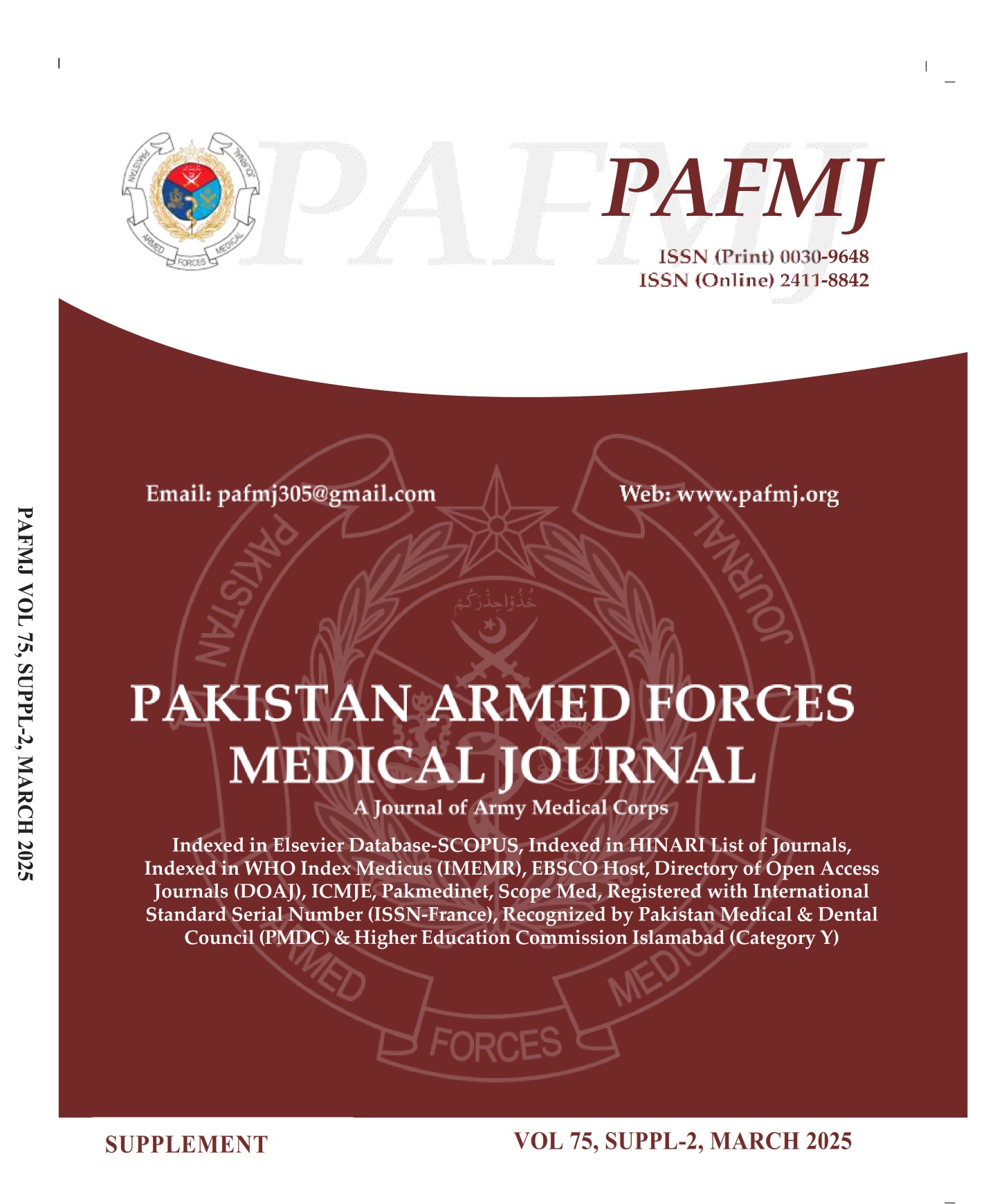Role of Montelukast in the Management of Moderate Inflammatory Acne
DOI:
https://doi.org/10.51253/pafmj.v75iSUPPL-2.12547Keywords:
Acne, Adjuvant, Doxycycline, Montelukast, TreatmentAbstract
Objective: To study the efficacy of montelukast as an adjunct in the treatment of moderate inflammatory acne.
Study Design: Quasi experimental Study.
Place and Duration of Study: Department of Dermatology, Pak Emirates Military Hospital, Rawalpindi Pakistan, from Apr to Oct 2023.
Methodology: This study was conducted on 150 patients with acne who needed systemic therapy. Group A (n=75) received 100 mg doxycycline daily plus placebo and the group B (n=75) received 100 mg daily doxycycline plus 10mg daily montelukast. Both groups also received topical benzoyl peroxide 4% every other night. The patients were evaluated for treatment efficacy by lesion count, Investigator Global Assessment, Global Acne Grading System, and Cardiff Acne Disability Index scoring systems after 12 weeks of intervention.
Results: The study included 150 patients with acne divided into two groups Group A 75(50%) and Group B 75(50%). All 150 patients included in the study showed improvement with the interventions. Individuals from Group B showed significantly superior reduction in the inflammatory as well as non-inflammatory lesion count (p-value <0.001). The decrease in Investigator Global Assessment, Global Acne Grading System, and Cardiff Acne Disability Index scores was also significant (all p-values<0.001) in comparison with group A.
Conclusion: Montelukast can be used as an adjuvant therapy along with other treatments of acne, especially for inflammatory variant.
Downloads
References
Dabash D, Salahat H, Awawdeh S, Hamadani F, Khraim H, Koni AA, et al. Prevalence of acne and its impact on quality of life and practices regarding self-treatment among medical students. Sci Rep 2024; 14: 4351.
https://doi.org/10.1038/s41598-024-55094-6
Common JEA, Barker JN, van Steensel M a. M. What does acne genetics teach us about disease pathogenesis? Br J Dermatol 2019; 181: 665–676.
https://doi.org/10.1111/bjd.17721
Cruz S, Vecerek N, Elbuluk N. Targeting Inflammation in Acne: Current Treatments and Future Prospects. Am J Clin Dermatol 2023; 24: 681–694.
https://doi.org/10.1007/s40257-023-00789-1
Mias C, Mengeaud V, Bessou‐Touya S, Duplan H. Recent advances in understanding inflammatory acne: Deciphering the relationship between Cutibacterium acnes and Th17 inflammatory pathway. Acad Dermatol Venereol 2023; 37: 3–11.
https://doi.org/10.1111/jdv.18794
Carniciu S, Hafi B, Gkini M ‐A., Tzellos T, Jafferany M, Stamu‐O’Brien C. Secondary psychiatric disorders and the skin. Dermatological Reviews 2023; 4: 162–171.
https://doi.org/10.1002/der2.211
Alsulaimani H, Kokandi A, Khawandanh S, Hamad R. Severity of Acne Vulgaris: Comparison of Two Assessment Methods. Clin Cosmet Investig Dermatol 2020; 13: 711–716.
https://doi.org/10.2147/CCID.S266320
McNeil MP, Luthy KE, Platt CR, Robinson MS, Macintosh JLB. First-Line Acne Treatment: Efficacy and Comparison of Cost. The Journal for Nurse Practitioners 2023; 19: 104616.
https://doi.org/10.1016/j.nurpra.2023.104616
Baldwin H. Oral Antibiotic Treatment Options for Acne Vulgaris. J Clin Aesthet Dermatol 2020; 13: 26–32.
Tobiasz A, Nowicka D, Szepietowski JC. Acne Vulgaris—Novel Treatment Options and Factors Affecting Therapy Adherence: A Narrative Review. JCM 2022; 11: 7535.
https://doi.org/10.3390/jcm11247535
Sanchez C, Keri J. Androgen Receptor Inhibitors in the Treatment of Acne Vulgaris: Efficacy and Safety Profiles of Clascoterone 1% Cream. CCID 2022; 15: 1357–1366.
https://doi.org/10.2147/CCID.S289750
Comparative Effects of Azithromycin and Probiotics for Treatment of Acne Vulgaris. J Coll Physicians Surg Pak 2023; 33: 516–520.
https://doi.org/10.29271/jcpsp.2023.05.516
Zouboulis CC. Endocrinology and immunology of acne: Two sides of the same coin. Experimental Dermatology 2020; 29: 840–859.
https://doi.org/10.1111/exd.14172
Aslam M, Raza N, Nadeem M. Comparison Of Oral Doxycyclin Ewith Oral Montelukast In The Treatment Of Moderate Acne Vulgaris. Pakistan Armed Forces Medical Journal 2020; 70: 797–800.
Fazelzadeh Haghighi N, Dastgheib L, Saki N, Alipour S, Ranjbar S. Montelukast as an effective adjuvant in the treatment of moderate acne vulgaris. Dermatologic Therapy 2022; 35.
https://doi.org/10.1111/dth.15770
(Babar O, Mobeen A. Prevalence and psychological impact of acne vulgaris in female undergraduate medical students of Rawalpindi and Islamabad, Pakistan. Cureus [Internet] 2019; 11(9): e5722.
Altunay I, Özkur E, Dalgard F, Gieler U, Aragones L, Lien L, et al. Psychosocial Aspects of Adult Acne: Data from 13 European Countries. Acta Derm Venerol 2020: 0.
https://doi.org/10.2340/00015555-3409
Öncü I, Gürel G, Akkoyun A. The Relationship of Acne With Somatosensory Amplification, Health Anxiety, and Depression Levels. Cureus 2022.
https://doi.org/10.7759/cureus.32314
Kelly KA, Balogh EA, Kaplan SG, Feldman SR. Skin Disease in Children: Effects on Quality of Life, Stigmatization, Bullying, and Suicide Risk in Pediatric Acne, Atopic Dermatitis, and Psoriasis Patients. Children 2021; 8: 1057.
https://doi.org/10.3390/children8111057
Eichenfield DZ, Sprague J, Eichenfield LF. Management of Acne Vulgaris: A Review. JAMA 2021; 326: 2055.
https://doi.org/10.1001/jama.2021.17633
Mohsin N, Hernandez LE, Martin MR, Does AV, Nouri K. Acne treatment review and future perspectives. Dermatologic Therapy 2022; 35.
https://doi.org/10.1111/dth.15719
Swallow M, Fan R, Cohen J, Bunick C. Antibiotic Resistance Risk with Oral Tetracycline Treatment of Acne Vulgaris. Antibiotics 2022; 11: 1032.
https://doi.org/10.3390/antibiotics11081032
Graber EM. Treating acne with the tetracycline class of antibiotics: A review. Dermatological Reviews 2021; 2: 321–330.
https://doi.org/10.1002/der2.49
Bagatin E, Costa CS. The use of isotretinoin for acne – an update on optimal dosing, surveillance, and adverse effects. Expert Review of Clinical Pharmacology 2020; 13: 885–897.
https://doi.org/10.1080/17512433.2020.1796637
Araviiskaia E, Layton AM, Estebaranz JLL, Ochsendorf F, Micali G. The Synergy between Pharmacological Regimens and Dermocosmetics and Its Impact on Adherence in Acne Treatment. Dermatology Research and Practice 2022; 2022: 1–10.
https://doi.org/10.1155/2022/3644720
Kerget B, Kerget F, Aydın M, Karaşahin Ö. Effect of montelukast therapy on clinical course, pulmonary function, and mortality in patients with COVID‐19. Journal of Medical Virology 2022; 94: 1950–1958.
https://doi.org/10.1002/jmv.27552
Rokni GR, Mohammadnezhad F, Saeedi M, Shadi S, Sharma A, Sandhu S, et al. Efficacy, tolerability, and safety of montelukast versus finasteride for the treatment of moderate acne in women: A prospective, randomized, single‐blinded, active‐controlled trial. J of Cosmetic Dermatology 2021; 20: 3580–3585.
Downloads
Published
License
Copyright (c) 2025 Ahmed Naveed Malik, Nadia Iftikhar , Sakina Sadiq Malik, Farrah Yousaf, Arfan Ul Bari, Aisha Akhtar

This work is licensed under a Creative Commons Attribution-NonCommercial 4.0 International License.















